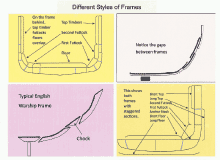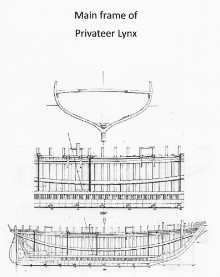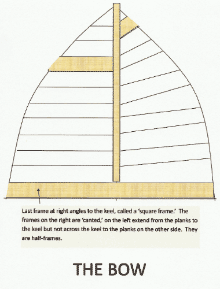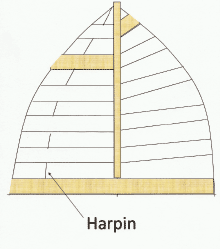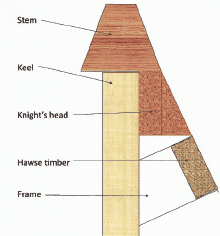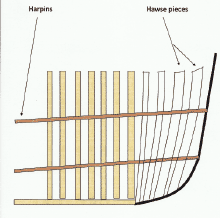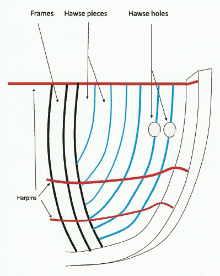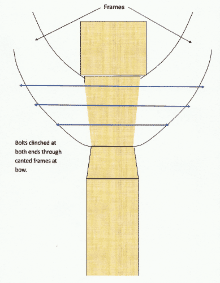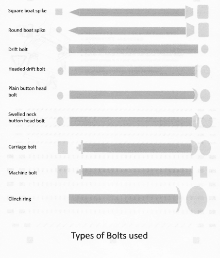
 Custom Search
|
|
| sails |
| plans |
| epoxy |
| rope/line |
| hardware |
| canoe/Kayak |
| sailmaking |
| materials |
| models |
| media |
| tools |
| gear |
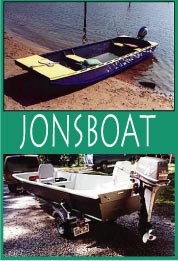 |
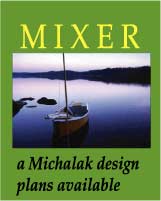 |
| join |
| home |
| indexes |
| classifieds |
| calendar |
| archives |
| about |
| links |
| Join Duckworks Get free newsletter Comment on articles CLICK HERE |
|
|
| Out There |
by Paul Austin - Dallas, Texas - USA Classic Ship Construction Notes - Part Three |
 |
Part One - Part Two - Part Three - Part Four - Part Five- Part Six FramesNow we come to the frames. On classic wood ships, frames were made from wood called 'flitch.' Frames were in two layers, made up of 6 to 10 sections. Usually the number of sections depended on what went on inside the hull. If the ship were a warship, more than one deck was required so the sections of each frame had to reflect that. The first section of the frame was called the floor, even though you never walk on it. The floor lay across the counter keel, bending slightly upward. The futtocks sat into each end of the floors with a joint, above the floors and curved nearly vertical. Above the futtocks were the top timbers, usually quite upright. If you've ever wondered how shipwrights found this goofy name, 'futtocks,' it is said to come from 'foot hooks.' Maybe this means the middle members of the frame had hooks for the feet while the men worked on the frames. Or maybe it means Soupy Sales was in charge of the Ark, I don't know. In any event, each of the three sections were joined with chocks and trunnels in England while on the continent the frame pieces were butt-jointed. They could do this when two layers were used for frames. Some ships had a filler one inch thick between frames to keep air circulating. When the frames were bolted to chocks the bolts were drilled inside dowels, whose holes were predrilled. This may have been to keep the metal bolts from conducting too much moisture directly to the frames. Later on Sir Robert Seppings had the chocks removed, to be replaced by butt-and-dowel joints. He said the chocks added nothing to the strength of the frames and contributed rot. Maybe this is where that British expression, 'all that rot,' came from. All that rot seems to have found a home when the chocks dried out and shrunk, leaving space for moisture and dirt. When the British realized the frames were drying out and shrinking also, they began the practice of putting tarred paper in the scarfs and joints. There is no record of anyone calling Sir Robert, 'Chocky' behind his back. I hope I'm first.
The frames were cut to a ratio of the ship's widest beam. The author and historian Duhamel says for a ship 12 feet wide at the widest beam, the frames would be 1/4 of 12 feet, or 3 feet. This may mean the entire width of two frames with a spacer. The space between frames was 6 to 10 inches, filled with salt to preserve the wood while leaving space for ventilation. Shipwrights in the 17th and 18th century feared rot more than grounding or combat. Limber holes were cut 2 inches square, on either side of the inner keel. Ships of many nations had chained plates to pull any debris through the holes. The square cut may have been to fit the square plates used to clear the holes. Now when construction began, the main frame or mid-ship frame was fitted first. In the earlier stages of frame construction it served as much as a spacer and crosspall as well. It might not be in the mathematical center of the waterline. The author Chapman says for 'sharply built' ships, the main frame was 1/20 of the ship's length in front of of the exact midpoint. French ships were closer to the midpoint, 1/38 of the ship's length in front of of the midpoint.
Next came the balance frame. Two of them were used, one just in front of the main frame and one just aft of it at the same distance. By the 18th century, balance frames were no longer used. Looking at ship lines from this century, the main section of these ships were not parallel any more. This may be due to the influence of American shipbuilding for speed above all, so that the gunwale was not perfectly straight anywhere along the waterline.
The foremost frame of the ship was not foremost in importance or even first from the bow. Putting in frames from the main frame toward the bow, the foremost frame was the last one set at right angles to the keel. From this frame to the bow, the space was filled with timbers set at right angles to the planks, not the keel. The specific angle of each frame was determined by the harpin, a long length of wood stretching from fashion piece to the stem on the outside of the frames, much like a spiling batten on smaller craft. The harpin was level to the waterline, guiding the insertion of the pieces that filled the space between the foremost frame and the stem. Sometimes the harpin was at the level of the deck, but not always. On the biggest ships, more than one harpin could be used.
Right next to the stem was a landing piece, called kinght's head. Alongside them were the hawse pieces, through which the hawse holes were drilled for the anchor chain. These filling members were thicker than the frames, sitting closer together than the frames. The bow takes a beating in heavy seas, so these members while fastened at angles weaker than 90 degrees had to be strong.
When the frames are set up, they are bolted through their floors into the keelson and keel. The half frames at the bow and stern are bolted athwartship from one cant frame across to the other.
These are the different bolts and their names. Usually a forger on site made these up by the thousands as the keel and stem with stern were being lofted and shaped.
Paul https://crossingthoughts-paul.blogspot.com.au ***** |
